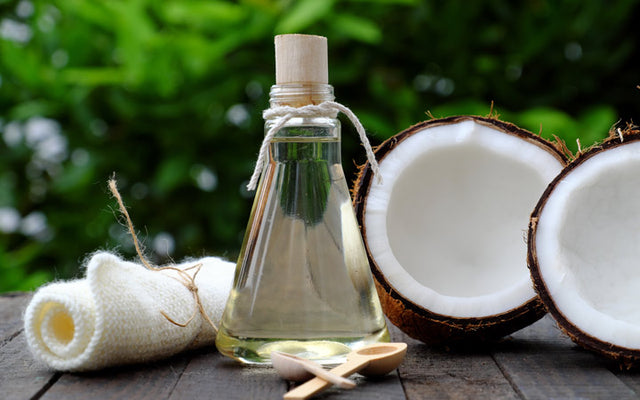Your grandmothers must have already told you that coconut oil can do wonders for your skin. However, the super ingredient that makes natural coconut oil so beneficial often goes unrecognized. We’re talking Lauric acid.
Lauric acid is the saturated fat present in coconut, palm oil and milk. Besides being rich in anti-bacterial and anti-inflammatory properties, lauric acid has several benefits for your skin. Read on to find out its many uses and how you can incorporate it in your daily skincare routine.
Highlights:
What Is Lauric Acid?
Lauric Acid [1] is a naturally derived fatty acid used in multiple skin care products. It is known for its properties to fight major skin conditions like xerosis cutis and psoriasis.
Though lauric acid occurs naturally in several plants and animal fats, coconut oil and palm kernel oil are key sources. It is also found in human tissues in solid and insoluble form. Studies indicate that in the human body, lauric acid stays relatively neutral.
With a slight odour of bay oil, lauric acid has many disease-fighting capabilities. When you consume lauric acid, it interacts with enzymes of your digestive tract that leads to the creation of Monolaurin. This works as an antimicrobial agent that fights against pathogens (infectious agents) and infections like common cold and flu.

What Foods Contain Lauric Acid?
1. Coconuts
Composition: 6.5 grams of lauric acid/ tablespoon
Coconut oil is a rich source of lauric acid along with caprylic acid, which is another useful fatty acid. To maximize the benefit from coconut oil, you can use it in food. Coconut milk can be added to dishes or coconut shreds can be blended into your smoothies or protein shakes. It helps to repair your skin internally.
2. Palm
Composition: 13 grams of lauric acid/ tablespoon
Palm kernel oil is also known for its high quantity of lauric acid. This can also be incorporated in cooking. However, don’t mix palm kernel oil with regular palm oil, as the latter has only a tiny amount of lauric acid.
3. Milk
Composition: 0.25 gram of lauric acid/ cup of milk
Consuming a cup of milk can also add to your intake of lauric acid. While cow and goat milk has lauric acid, the highest quantity is found in human breast milk, which makes it extremely beneficial to infants. 3 percent of the total fat of milk is made of lauric acid, and one full cup of milk can provide you with 8 grams of fat, which has 0.25 grams of lauric acid.

Benefits of Lauric Acid For Skin
1. Psoriasis Treatment
Psoriasis [2] is an autoimmune skin condition that leads to redness and scaly skin. It can be painful and also cause skin inflammation. Coconut oil is used as treatment for this skin condition, as lauric acid provides high moisturizing effects. Additionally, its anti-inflammatory properties help to reduce inflammation. A study conducted in 2013, also indicates the same. Here, the researcher mixed coconut oil and skin lotion, which resulted in an increase in skin hydration and skin elasticity.
2. Acne Treatment
The antibacterial components make lauric acid extremely effective against acne. Propionibacterium bacteria is one of the main reasons for acne. An antibacterial property study [3] found that lauric acid not only reduces inflammation, but also kills the acne causing bacteria. Besides this, results show that lauric acid worked better than benzoyl peroxide, which is considered to be a common cure for acne.
3. Xerosis Cutis Treatment
The condition of having abnormally dry skin is medically termed as xerosis cutis [4]. It is a common skin condition among the elderly. Though it does cause discomfort, it is not a permanent situation, and can be cured. Lauric acid has moisturizing abilities. Experts recommend using coconut oil, enriched with lauric acid as a treatment. The fatty acid helps replace the lipid component in skin cells, making it supple again.
4. Anti- Ageing Properties
Many anti-ageing skincare products use coconut oil and palm kernel oil as their base ingredient. The saturated fatty acid of these oils work as an anti-ageing agent and reduce the fine lines and wrinkles on your face. Even anti-ageing home remedies suggest using coconut oil as the carrier oil, for this reason.
How To Use Lauric Acid?
Lauric acid can be applied directly to your skin. But if you have acne, restrain from applying it directly. You can instead, opt for an anti-acne product that has lauric acid in it. While there is no recommended quantity or dosage to be used, it will depend on multiple factors like the user’s age, skin condition and other medical issues.
Side-Effects Of Lauric Acid
Not many studies have been conducted to prove the safety of lauric acid. However, Food and Drug Administration [5] has declared “Monolaurin [6]” as a treatment for any medical condition. This, as we have read before, is also a chemical derived from lauric acid.
Wrapping Up
Lauric acid has multiple skin benefits to offer. Therefore, you can either go for products with lauric acid or incorporate a diet enriched with it. Whatever you choose, your skin will thank you. Since there is no dosage suggestion for lauric acid, use it judiciously. In case you have a severe skin condition, do take advice from your dermatologist. To get a personalized overview of your skin, take SkinKraft’s SkinID test and grab the tailor-made products that address your specific skin concerns.
Recommended Products
Was this Article helpful?
- Least helpful
- Most helpful











